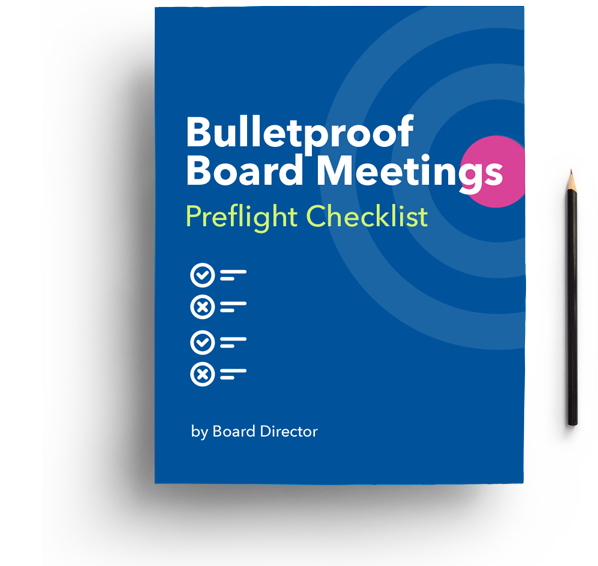How to Run a Board Meeting
A systematic approach for running excellent board meetings
By Grace Zientarski
Board meetings are the collaborative cornerstones to advance your organization toward its goals. Running a board meeting can come with its challenges, but a systematic approach can allow you to make the most of valuable time. Many board chairs apply Robert’s Rules of Order as their method of procedure to encourage efficient and fair meetings. Robert’s Rules provides a framework of steps that allow you to keep order and streamline the productivity for how to run a board meeting.
Robert’s Rules of Order is a manual of parliamentary rules and procedures that focuses on how to run board meetings and make group decisions. By Robert’s Rules, board members can raise motions to vote on decisions. It’s a democratic process with specific steps to run an orderly meeting.
Many organizations apply Robert’s Rules to their board meetings as a consistent method. In general, the order for how to run board meetings that follow Robert’s Rules typically look like this:
- Call to Order
- Roll Call
- Approval of Previous Minutes and Current Agenda
- Reports of Officers and Committees
- Standard Order of Business
- Adjournment
You may have to rearrange the order depending on what your organization needs to accomplish, and you can also utilize a consent agenda to group approval for routine and non-controversial items. But before determining this, you should be familiar with each step for how to run a board meeting.
Call to Order
Begin each meeting with a call to order. It’s a simple statement to greet board members and begin. Note the time, date, and call the meeting to start. Always do this at the designated time to let board members know you value their time.
Roll Call
The board secretary typically performs this by calling the names of everyone who’s in attendance and noting who is not. It determines if enough people are present to meet the quorum, the minimum number of board members to conduct official business. Your quorum will vary based on the total number of board members and the requirement set by your state laws.
Approval of Previous Minutes and Current Agenda
Read last meeting’s minutes and the current meeting’s agenda. Distribute these documents beforehand for board members to review, so this step will ensure everyone is on the same page. The approval must be unanimous to continue.
Related: How to Prepare for a Board Meeting
Reports of Officers and Committees
Officers and committees read reports to inform board members where finances and projects stand. Protocol usually suggests distributing these in advance since their purpose is typically to provide information. Unless the speaker recommends a specific course of action, time spent on these should be brief.
Related: How To Be An Exceptional Nonprofit Board Member
Standard Order of Business
You should pace the meeting to dedicate the most time to the standard order of business. The standard order of business is where board members discuss and make decisions that move your organization forward. You may rearrange these steps to prioritize what your organization needs most, but many board chairs follow this order when running a board meeting:
Unfinished Business
Unfinished business is often referred to as “old business.” Many find that name misleading because it implies that this category only includes previously discussed matters. Instead, unfinished business can fall into three categories: any matter left pending when the last meeting adjourned, any matter left unaddressed from previous meetings, or any matter postponed to the current meeting’s agenda. Have the board vote on items ready for approval first. If any matters need additional discussion, ask board members to save those items for the discussion portion of the meeting.
New Business
After settling any unfinished business, announce new business matters. These are the items that have been determined ahead of time and listed on the agenda for discussion. As board chair, it’s your job to open the room and facilitate the conversation. You should only allow one speaker at a time and encourage full participation by letting every board member speak. But you may have to limit dialogue if it becomes lengthy or digressive so the meeting can cover multiple topics. When you are running a board meeting, make sure there are no loose ends or confusion about where an item stands. Every item should be voted on, moved to a committee for consideration, or tabled to the next meeting’s agenda.
Other Business
Save some time at the end of the meeting for any other business. Here, you can open it up to board members to raise business matters that weren’t on the agenda after finishing the planned topics. Board members might use this to make announcements or present new ideas for review and future discussion. Opening this invitation encourages effective communication and engagement.
Related: Executive Presence: How to Impress and Inspire Your Board
Adjournment
Try to limit meetings to last two hours or less and end it on time. If you feel that it must go longer, suggest a break. Just as you started, state the time for the minutes. When you close the meeting, tie any loose ends by taking questions or comments and thank everyone in attendance for their participation.
After the meeting, send a follow-up email to thank your board again. You can also use post-meeting emails to attach a short electronic survey for feedback from board members and receive valuable insight for how to run the next board meeting. Either way, board members will appreciate your follow-through.
Building your board meeting agenda and board packet can be easier than ever.
Board Director’s Agenda Builder is one of the tools board administrators use to streamline board meeting communications without email. It saves time and money!
Give it a try FREE at BoardDirector.co
Call us today for more information! +1 (302) 650-1709

